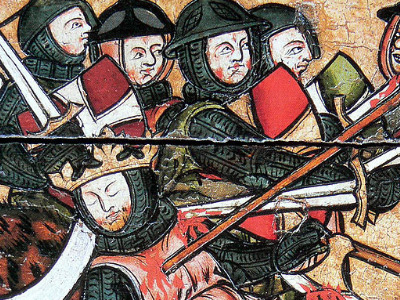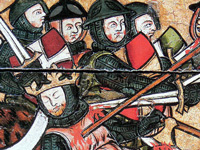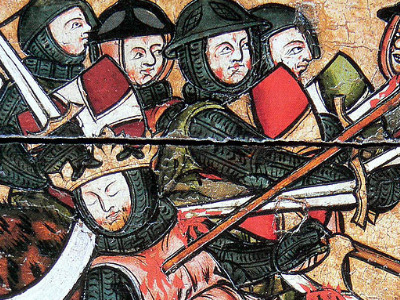Battle of Stiklestad (1030)

Battle
According to saga sources, Olaf traveled with his 3,600 man army through Sweden and crossed the mountains into the valley of Verdal (Old Norse: Veradalr), about 80 kilometres (50 mi) north of the city of Trondheim. Olaf and his men arrived at Stiklestad, a farm in the lower part of the valley. This was where the Battle of Stiklestad took place, as described by Snorri Sturluson in his famous work Heimskringla, written about 200 years later.
At Stiklestad, Olaf met an army led by Hárek of Tjøtta (Old Norse: Hárekr ór Þjóttu), Thorir Hund from Bjarkøy and Kálfr Árnason, a man who previously served Olaf. The peasant army consisted of one hundred hundred according to Snorri, which in long hundreds means 14,400, and not 10,000. He states that the battle cry of Olaf's men was Fram! Fram! Kristmenn, krossmenn, kongsmenn! (Forward! Forward! Men of Christ, men of the cross, men of the king!), while that of the opposing army was Fram! Fram! Bonder! (Forward! Forward! farmers!).
According to Snorri, Olaf received three severe wounds—in the knee, in the neck, and while leaning against a large stone the final mortal spear thrust up under his mail shirt and into his belly. According to saga sources, Thorir was among those who gave Olaf his lethal wounds, together with Kalv Arnesson and Torstein Knarresmed from Rovde in Sunnmøre. While earlier sources do not specify who dealt the king his blows, Snorri makes Thorir Hund responsible for the latter, using the spear that had killed his nephew and set the fallout between the king and Thorir in motion. During the Battle of Stiklestad, King Olaf almost killed Thorir Hund with a war hammer. However, Torstein Knarresmed managed to get between them and gave Olaf a wound right above his left knee. Shortly later Thorir Hund thrust his spear into the king's stomach before Kalv Arnesson struck the king in the throat with his sword. Torstein Knarresmed was subsequently killed by a blow in the back but was revenged later that same day by one of Thorir's men. The king's body was carried away and buried secretly in the sandy banks of the Nidelva River south of the city of Trondheim.
HISTORY

RESOURCES
This article uses material from the Wikipedia article "Battle of Stiklestad (1030)", which is released under the Creative Commons Attribution-Share-Alike License 3.0.
© Stories Preschool. All Rights Reserved.









